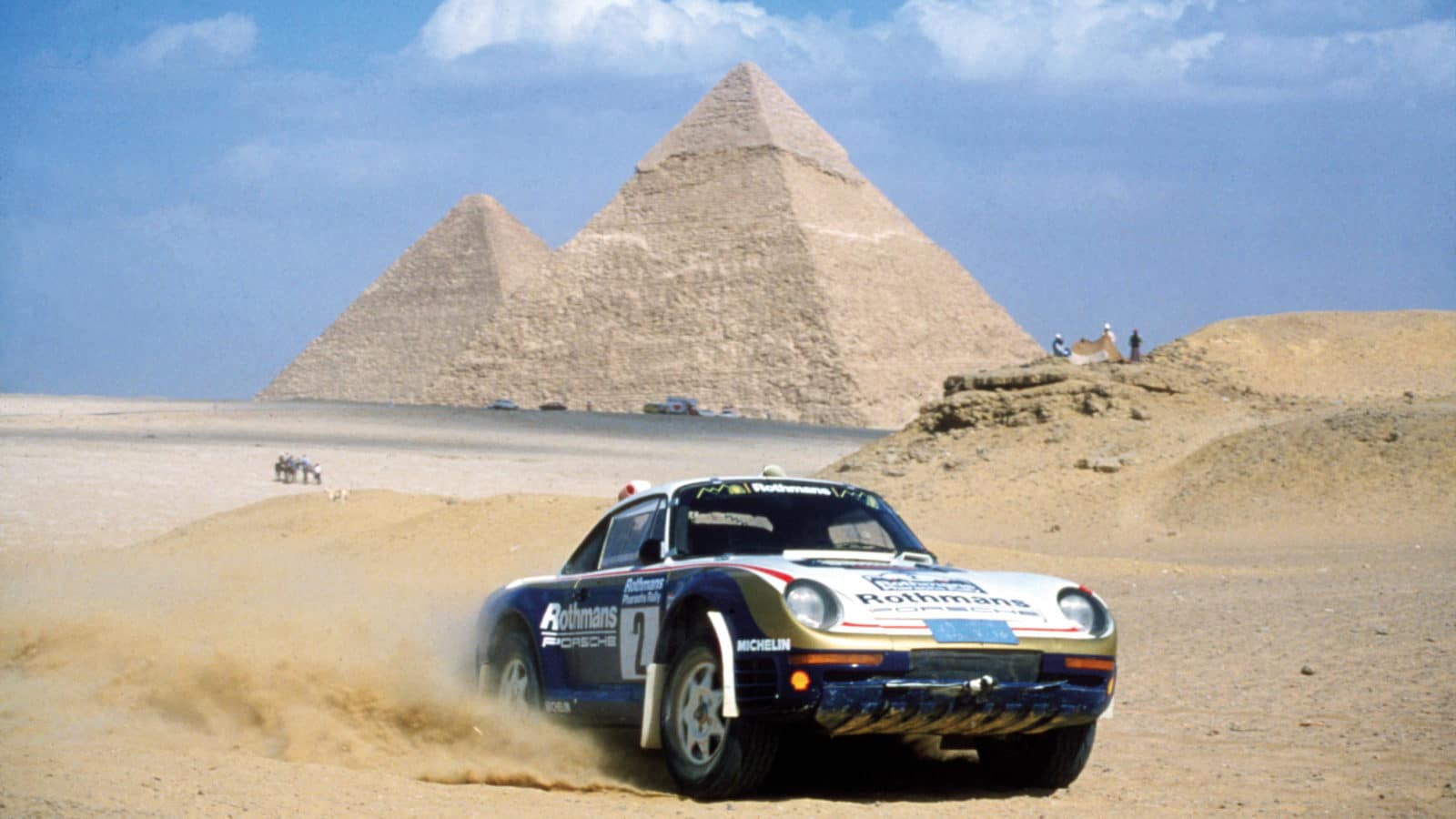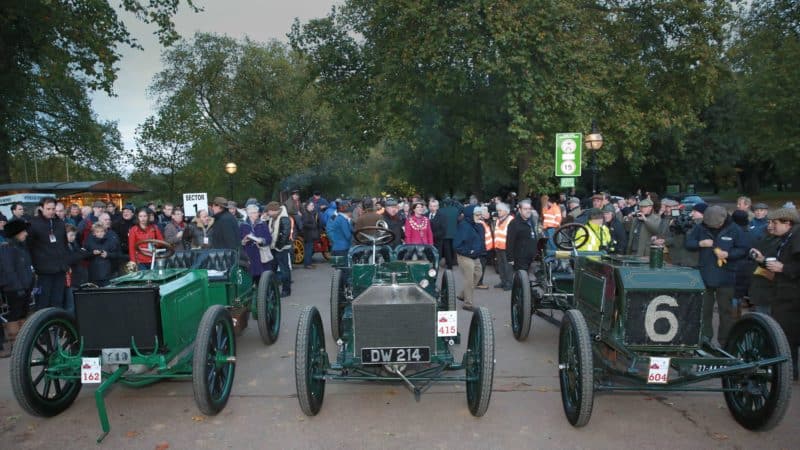Letters January 2023

The first victory for Porsche’s 959 came on the 1985 Pharaohs Rally, not’86 Dakar
Porsche AG
Anthony Peacock’s look back at Group B rally cars [Group B top 10 drives, December] was wonderfully evocative, but the Porsche 959 record needs putting straight; the 1986 Paris-Dakar was not its debut win. I was Rothmans Porsche press officer during the 1980s, principally working in Group C sports car racing, but I was seconded to the Paris-Dakar programme as Porsche gradually developed its four-wheel-drive system for rallying. In 1984 it entered two 911 Carrera 4WD hybrids, known as 953s, one of which won the Dakar with René Metge. The following year the 959 body was first used, with the 953 engine and 4WD, but both Metge and Jackie Ickx retired. The push was now for the 959 to have the twin-turbo flat-six engine in time for the 1986 Dakar, but first came the 1985 Pharaohs Rally in Egypt, in which the first two definitive Rothmans 959s were entered; Ickx’s car burned out before the Pyramids start, but Middle Eastern rally champions Saeed Al-Hajri and John Spiller went on to the Group B car’s debut win.
As Anthony says, the 1986 Dakar win was a crushing one, and the other two Rothmans 959s placed second and sixth, but it was not the first victory for the car.
Mark Cole, Buckingham
Johnny Herbert’s article on the Formula 1 budget overspend issue [Opinion, December] was, as would be expected, both well-reasoned and frank. However, punishment should fit the crime and if we are going to talk about credibility, stop right there, because all credibility was destroyed by the way the FIA dealt with last year’s result. How “wrong” did that look for “our” sport, Johnny? If you cheat, be prepared to pay the price.
John Adair, London
I was dismayed to read that Johnny Herbert felt that to exclude Red Bull from the 2021 championship would “make a mockery of the sport”. All sports must be governed to their rules, no shades of grey or secret deals. It is not governing properly that makes a mockery of sport. Cycling banned Lance Armstrong and retrospectively stripped him of his titles when he admitted doping. Cyclists failing drugs tests aren’t just banned from the event, they are banned for years. F1 excluded Ferrari and Michael Schumacher from the 1997 championship when he took Jacques Villeneuve out of the race. Sports move on, away from the cheats.
If a car doesn’t conform to the regulations, it is excluded from the sessions in which it ran in such configuration. In practice and qualifying, times are deleted and the car goes to the back; in a race it is disqualified. The cost cap breach is no different. To allow breaches to go unpunished or receive a mere slap on the wrist sets the wrong precedent and moves the limit, which others will then use and accept the small fine that will follow. It’s simply allowing teams to buy their way out of trouble.
F1 has to man up and govern its sport to stop it becoming a mockery. Set the right precedent now and no one will go near the cost cap limit again.
Richard Palmer, Surrey
Your editorial in the October issue [The Editor] brought back many memories of Gerry Birrell. I first met him when he kept his F3 Brabham at the yard in North Street, Clapham. There were lots of motor racing people, Albert Betts, Palliser FF cars, Ray Race, and Mark Konig with his Nomad BRM. At that time I worked for the Konig family including Gabriel Konig and after that Andrew Mylius, who built the Chevron B8-based Gropa. You will recall that Gerry raced this car at the Brands Hatch and Nürburgring 1000Kms in 1970.
Chatting to Gerry was always interesting, and if I had a spare weekend I used to go along just to watch him, and provide an ear if he wanted to vent his displeasure about something. Once he moved up to F2 I never spoke to him again but when he had the accident it upset me considerably. I had been a mechanic in F3 for a few years and seen a lot of death with people I knew, but Gerry was different.
Julian Pratt, Bethania, Llanon, mid-wales
I was delighted to read in the November edition [Matters of Moment] that SF Edge’s 1902 Gordon Bennett Cup-winning Napier would be appearing with its siblings on this year’s London-Brighton Veteran Car Run. However, Selwyn’s victory did not set the trend for racing green, which was first adopted as Britain’s national racing colour the following year as a tribute to the island of Ireland, which – as racing on public roads was not permitted on the British mainland – was hosting the Cup’s defence. For the 1902 Gordon Bennett race, the two British entries (Edge’s Napier and White’s Wolseley) had actually been painted red, the only other competing nation that year being France, whose three entries were all painted blue.
James Thorne, Farnham, Surrey

Trio of GB Napier before the Brighton Run – but in 1902 Selwyn Edge’s car, left, was painted red
Matt Alexander
Regarding the Parting Shot photo of Peter Hughes in the September issue, in the late ’50s Peter was here in the UK studying at Loughborough College, now University. Some of us students got together and booked the Club Circuit at Silverstone for a ‘track day’. We were watched by Silverstone’s John Brown, who sat on a wooden box. Afterwards he said we had all been ‘average’ except for the fast Ford. He said that he usually just sat on the wooden box which contained a field telephone, but when Peter’s Ford came round the first time he opened the front of the box. Next time he took the phone out of the box. The time after, he plugged it in! However, he hadn’t needed it. The year after your photo was taken Peter won the 1964 Safari Rally outright!
Don MacLean, Clifton upon Teme, Worcester
Reading Gordon Cruickshank’s article entitled No-faster goodies [Automobilia, December] reminded me that many, many years ago when I was young and foolish, I stumbled across a red XR2 stick-on windscreen sunstrip in the bargain bucket area of my local Halfords.
Pleased as punch with my ‘bargain’ I duly set about fitting it in my Mark 1 red XR2 only to find that the rearview mirror got in the way of the application proceedings. “No problem,” thought I, and popped the mirror off its ball joint mount that was stuck to the top centre of the windscreen.
Sunstrip duly mounted and all bubbles smoothed out, I then popped the mirror back on its mount only to see (and hear) a dirty great crack appear in the windscreen from top to bottom when I pushed the mirror back on.
Fifty pounds later, I had replaced the screen (with the sunstrip on too). Not such a bargain after all. One lives and learns!
Rob Gent, Spalding, Lincolnshire
Doug Nye’s article regarding autographs [The Archives, November], including his mention of Frank Gardner, brought back some fond memories of Frank.
I knew Frank well and we would meet regularly for lunch. On one such occasion I mentioned to him that I had both the autobiographies of Sid Watkins. To my surprise Frank had not seen them so at our next lunch I loaned them to him. It took a couple of months to get them back, which was fine and when he did return them he said, “Look inside,” which I did. It was a week or two after the Australian GP in Melbourne and Frank, who generally went down from Queensland, had taken the books with him and had both personally signed by the Professor. It was a wonderful gesture and greatly appreciated. Needless to say, I still have the books.
Peter Tett, Brisbane, Australia
I read your editor’s piece in the December magazine [The Editor] about the demise of the all-female W Series.
Is it me or does the W Series seem a bit pointless since it offers very little to the women that drive in it? Surely the purpose of such a series is to showcase women’s driving and prove that they can compete with men on an equal footing. Shouldn’t the winner be offered a Friday seat in one F1 team at a GP weekend and a series seat in F2 or at least F3.

Shouldn’t success in the W Series have been rewarded by prize drives in Formula 2 or 3?
Formula 1 via Getty Images
Racing cars is one of the few sports where women should be able to compete directly with men in the same equipment. There has been lots of noise from the likes of David Coulthard, Suzi Wolff and Sky F1 who televise the races saying how wonderful it is, but surely the elephant in the room is – why aren’t they driving in F2 or F3?
Shouldn’t the founder of this series Catherine Bond Muir and the FIA, if they’re serious about this, really make this series worthwhile? Yes, Jamie Chadwick won back-to-back titles and the inaugural series in 2019, but all she’s got out of it is a development drive with Williams.
Graeme Russell, Eastbourne
Mark Hughes is a wonderfully expert reporter of all things F1. But as I read his report on the French and Hungarian GPs in the October issue [Leclerc’s pain boosts Verstappen’s pain], I couldn’t help but despair, as so much of the discussion pertained to tyres! As a long time follower of the sport, I’ve often said to my oldest who is carrying on the tradition: “three tyres – dry, inter and wet! That’s it!” Mark’s excellent (as always) write-up reinforced my convictions in this regard. Give ’em one dry tyre, I say, as that’s the majority percentage of the racing, and let driver skill have more of a role again.
RH Adam Howell, New Hope, Pennsylvania, USA
Why does Martin Brundle continue to put his microphone in front of ‘celebrities’ (sic), who embarrass themselves by refusing to speak to F1’s voice of reason and experience?
The latest was Brad Pitt at the US GP in COTA, who supposedly is making a film about F1 in the company of Lewis Hamilton. And yet… he displays ignorance beyond measure, as he apparently tried to avoid mixing with ‘riff-raff’ on the grid,
With that in mind this is my challenge to Martin. Ignore the time-wasters, and concentrate on the unknowns who walk the grid. Find out who they are, where they come from, which team(s) they have been invited by, and why? It might or might not work, but it has to be better than groaning at the TV following another prima donna moment.
Mike Hayden, Branton, Doncaster
Contact us
Write to Motor Sport, 18-20 Rosemont Road, London, NW3 6NE
e-mail, [email protected]
